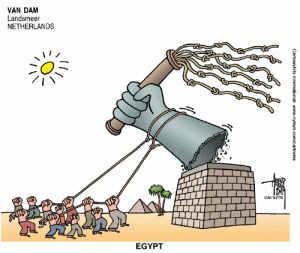Like everyone else in the rest of the world, I’ve been following the momentous events occurring in Egypt. But reading all the articles, editorials, analyses, and blog posts is a lot of work. Fortunately, there are editorial cartoons, an ancient medium dedicated to providing news to the illiterate and the very lazy.
Editorial cartoons lack the space for any nuanced commentary, so instead they impart a simple message that elicits an immediate emotional response from the reader. Of course, that response can vary depending upon the biases and assumptions of both the artist and the audience. After reviewing all the cartoons I could find addressing the Egyptian protests [primarily from the United States], I noticed that most of them were designed to elicit one of four reactions: joy, fear, ambivalence, or self-criticism.
Joy
Simply put, the overthrow of a dictator is a time for joy.
By Arend van Dam
The people literally become hands that drag down the flail of oppression. Though its not the best idea to bring down the flail on top of yourself.
.


